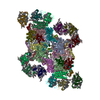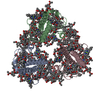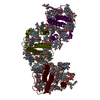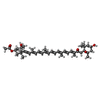[English] 日本語
 Yorodumi
Yorodumi- PDB-8w4p: Structure of PSII-FCPII-I/J/K complex in the PSII-FCPII supercomp... -
+ Open data
Open data
- Basic information
Basic information
| Entry | Database: PDB / ID: 8w4p | ||||||
|---|---|---|---|---|---|---|---|
| Title | Structure of PSII-FCPII-I/J/K complex in the PSII-FCPII supercomplex from Cyclotella meneghiniana | ||||||
 Components Components |
| ||||||
 Keywords Keywords |  PHOTOSYNTHESIS / PSII-FCPII PHOTOSYNTHESIS / PSII-FCPII | ||||||
| Function / homology | Chem-A86 /  CHLOROPHYLL A / Chem-DD6 CHLOROPHYLL A / Chem-DD6 Function and homology information Function and homology information | ||||||
| Biological species |  Stephanocyclus meneghinianus (Diatom) Stephanocyclus meneghinianus (Diatom) | ||||||
| Method |  ELECTRON MICROSCOPY / ELECTRON MICROSCOPY /  single particle reconstruction / single particle reconstruction /  cryo EM / Resolution: 3.48 Å cryo EM / Resolution: 3.48 Å | ||||||
 Authors Authors | Shen, L.L. / Li, Z.H. / Shen, J.R. / Wang, W.D. | ||||||
| Funding support |  China, 1items China, 1items
| ||||||
 Citation Citation |  Journal: Nat Commun / Year: 2023 Journal: Nat Commun / Year: 2023Title: Structural insights into photosystem II supercomplex and trimeric FCP antennae of a centric diatom Cyclotella meneghiniana. Authors: Songhao Zhao / Lili Shen / Xiaoyi Li / Qiushuang Tao / Zhenhua Li / Caizhe Xu / Cuicui Zhou / Yanyan Yang / Min Sang / Guangye Han / Long-Jiang Yu / Tingyun Kuang / Jian-Ren Shen / Wenda Wang /   Abstract: Diatoms are dominant marine algae and contribute around a quarter of global primary productivity, the success of which is largely attributed to their photosynthetic capacity aided by specific ...Diatoms are dominant marine algae and contribute around a quarter of global primary productivity, the success of which is largely attributed to their photosynthetic capacity aided by specific fucoxanthin chlorophyll-binding proteins (FCPs) to enhance the blue-green light absorption under water. We purified a photosystem II (PSII)-FCPII supercomplex and a trimeric FCP from Cyclotella meneghiniana (Cm) and solved their structures by cryo-electron microscopy (cryo-EM). The structures reveal detailed organizations of monomeric, dimeric and trimeric FCP antennae, as well as distinct assemblies of Lhcx6_1 and dimeric FCPII-H in PSII core. Each Cm-PSII-FCPII monomer contains an Lhcx6_1, an FCP heterodimer and other three FCP monomers, which form an efficient pigment network for harvesting energy. More diadinoxanthins and diatoxanthins are found in FCPs, which may function to quench excess energy. The trimeric FCP contains more chlorophylls c and fucoxanthins. These diversified FCPs and PSII-FCPII provide a structural basis for efficient light energy harvesting, transfer, and dissipation in C. meneghiniana. | ||||||
| History |
|
- Structure visualization
Structure visualization
| Structure viewer | Molecule:  Molmil Molmil Jmol/JSmol Jmol/JSmol |
|---|
- Downloads & links
Downloads & links
- Download
Download
| PDBx/mmCIF format |  8w4p.cif.gz 8w4p.cif.gz | 127.6 KB | Display |  PDBx/mmCIF format PDBx/mmCIF format |
|---|---|---|---|---|
| PDB format |  pdb8w4p.ent.gz pdb8w4p.ent.gz | 96.4 KB | Display |  PDB format PDB format |
| PDBx/mmJSON format |  8w4p.json.gz 8w4p.json.gz | Tree view |  PDBx/mmJSON format PDBx/mmJSON format | |
| Others |  Other downloads Other downloads |
-Validation report
| Arichive directory |  https://data.pdbj.org/pub/pdb/validation_reports/w4/8w4p https://data.pdbj.org/pub/pdb/validation_reports/w4/8w4p ftp://data.pdbj.org/pub/pdb/validation_reports/w4/8w4p ftp://data.pdbj.org/pub/pdb/validation_reports/w4/8w4p | HTTPS FTP |
|---|
-Related structure data
| Related structure data |  37268MC  8j5kC  8j7zC  8w4oC M: map data used to model this data C: citing same article ( |
|---|---|
| Similar structure data | Similarity search - Function & homology  F&H Search F&H Search |
- Links
Links
- Assembly
Assembly
| Deposited unit | 
|
|---|---|
| 1 |
|
- Components
Components
-Protein , 3 types, 3 molecules p43
| #1: Protein | Mass: 23279.170 Da / Num. of mol.: 1 / Source method: isolated from a natural source / Source: (natural)  Stephanocyclus meneghinianus (Diatom) Stephanocyclus meneghinianus (Diatom) |
|---|---|
| #2: Protein | Mass: 13039.064 Da / Num. of mol.: 1 / Source method: isolated from a natural source / Source: (natural)  Stephanocyclus meneghinianus (Diatom) Stephanocyclus meneghinianus (Diatom) |
| #3: Protein | Mass: 17850.197 Da / Num. of mol.: 1 / Source method: isolated from a natural source / Source: (natural)  Stephanocyclus meneghinianus (Diatom) Stephanocyclus meneghinianus (Diatom) |
-Non-polymers , 3 types, 38 molecules 




| #4: Chemical | ChemComp-CLA /  Chlorophyll a Chlorophyll a#5: Chemical | ChemComp-A86 / (  Fucoxanthin Fucoxanthin#6: Chemical |  Diadinoxanthin Diadinoxanthin |
|---|
-Details
| Has ligand of interest | Y |
|---|
-Experimental details
-Experiment
| Experiment | Method:  ELECTRON MICROSCOPY ELECTRON MICROSCOPY |
|---|---|
| EM experiment | Aggregation state: PARTICLE / 3D reconstruction method:  single particle reconstruction single particle reconstruction |
- Sample preparation
Sample preparation
| Component | Name: Cm-PSII-FCPII-I/J/K / Type: COMPLEX Details: Cm-PSII-FCPII-I/J/K complex in the PSII-FCPII supercomplex from Cyclotella meneghiniana Entity ID: #1-#3 / Source: NATURAL |
|---|---|
| Source (natural) | Organism:  Stephanocyclus meneghinianus (Diatom) Stephanocyclus meneghinianus (Diatom) |
| Buffer solution | pH: 6.5 |
| Specimen | Embedding applied: NO / Shadowing applied: NO / Staining applied : NO / Vitrification applied : NO / Vitrification applied : YES : YES |
Vitrification | Cryogen name: ETHANE |
- Electron microscopy imaging
Electron microscopy imaging
| Experimental equipment |  Model: Titan Krios / Image courtesy: FEI Company |
|---|---|
| Microscopy | Model: FEI TITAN KRIOS |
| Electron gun | Electron source : :  FIELD EMISSION GUN / Accelerating voltage: 300 kV / Illumination mode: FLOOD BEAM FIELD EMISSION GUN / Accelerating voltage: 300 kV / Illumination mode: FLOOD BEAM |
| Electron lens | Mode: BRIGHT FIELD Bright-field microscopy / Nominal defocus max: 2500 nm / Nominal defocus min: 1500 nm Bright-field microscopy / Nominal defocus max: 2500 nm / Nominal defocus min: 1500 nm |
| Image recording | Electron dose: 50 e/Å2 / Film or detector model: GATAN K2 SUMMIT (4k x 4k) |
- Processing
Processing
CTF correction | Type: PHASE FLIPPING AND AMPLITUDE CORRECTION | ||||||||||||||||||||||||
|---|---|---|---|---|---|---|---|---|---|---|---|---|---|---|---|---|---|---|---|---|---|---|---|---|---|
3D reconstruction | Resolution: 3.48 Å / Resolution method: FSC 0.143 CUT-OFF / Num. of particles: 314409 / Symmetry type: POINT | ||||||||||||||||||||||||
| Refine LS restraints |
|
 Movie
Movie Controller
Controller





 PDBj
PDBj







